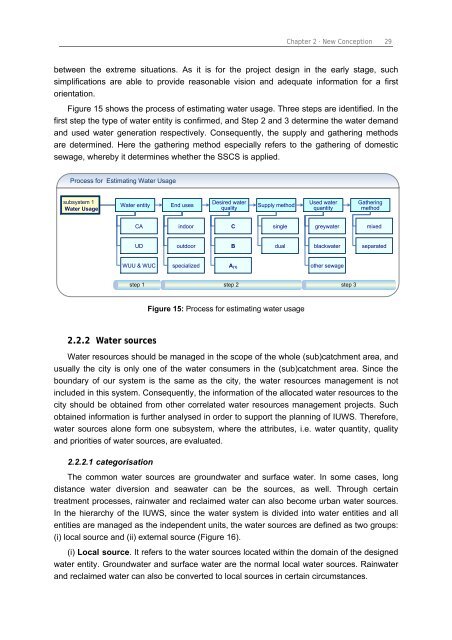Chapter 3 Decision Support Model (IUWS-DSM) - Tubdok
Chapter 3 Decision Support Model (IUWS-DSM) - Tubdok
Chapter 3 Decision Support Model (IUWS-DSM) - Tubdok
You also want an ePaper? Increase the reach of your titles
YUMPU automatically turns print PDFs into web optimized ePapers that Google loves.
<strong>Chapter</strong> 2 · New Conception 29<br />
between the extreme situations. As it is for the project design in the early stage, such<br />
simplifications are able to provide reasonable vision and adequate information for a first<br />
orientation.<br />
Figure 15 shows the process of estimating water usage. Three steps are identified. In the<br />
first step the type of water entity is confirmed, and Step 2 and 3 determine the water demand<br />
and used water generation respectively. Consequently, the supply and gathering methods<br />
are determined. Here the gathering method especially refers to the gathering of domestic<br />
sewage, whereby it determines whether the SSCS is applied.<br />
Process for Estimating Water Usage<br />
subsystem 1<br />
Water Usage<br />
Water entity<br />
CA<br />
UD<br />
WUU & WUC<br />
step 1<br />
2.2.2 Water sources<br />
End uses<br />
indoor<br />
outdoor<br />
specialized<br />
Desired water<br />
quality<br />
C single<br />
B<br />
A(1)<br />
step 2<br />
Supply method<br />
dual<br />
Figure 15: Process for estimating water usage<br />
Used water<br />
quantity<br />
greywater<br />
blackwater<br />
other sewage<br />
step 3<br />
Gathering<br />
method<br />
mixed<br />
separated<br />
Water resources should be managed in the scope of the whole (sub)catchment area, and<br />
usually the city is only one of the water consumers in the (sub)catchment area. Since the<br />
boundary of our system is the same as the city, the water resources management is not<br />
included in this system. Consequently, the information of the allocated water resources to the<br />
city should be obtained from other correlated water resources management projects. Such<br />
obtained information is further analysed in order to support the planning of <strong>IUWS</strong>. Therefore,<br />
water sources alone form one subsystem, where the attributes, i.e. water quantity, quality<br />
and priorities of water sources, are evaluated.<br />
2.2.2.1 categorisation<br />
The common water sources are groundwater and surface water. In some cases, long<br />
distance water diversion and seawater can be the sources, as well. Through certain<br />
treatment processes, rainwater and reclaimed water can also become urban water sources.<br />
In the hierarchy of the <strong>IUWS</strong>, since the water system is divided into water entities and all<br />
entities are managed as the independent units, the water sources are defined as two groups:<br />
(i) local source and (ii) external source (Figure 16).<br />
(i) Local source. It refers to the water sources located within the domain of the designed<br />
water entity. Groundwater and surface water are the normal local water sources. Rainwater<br />
and reclaimed water can also be converted to local sources in certain circumstances.

















